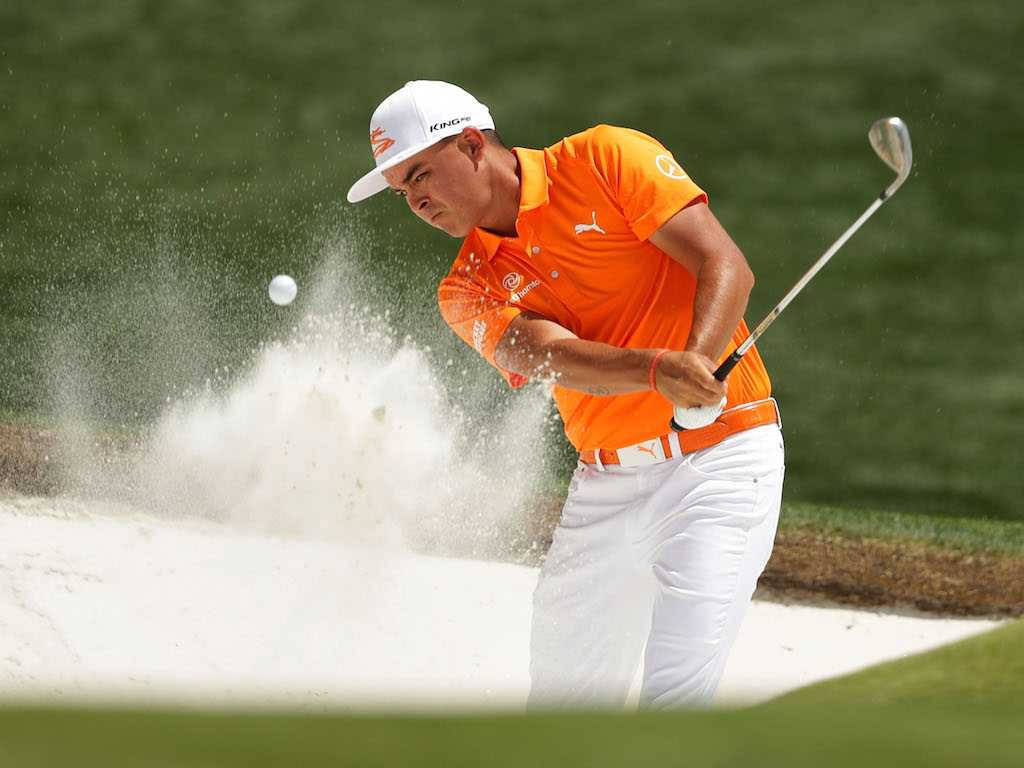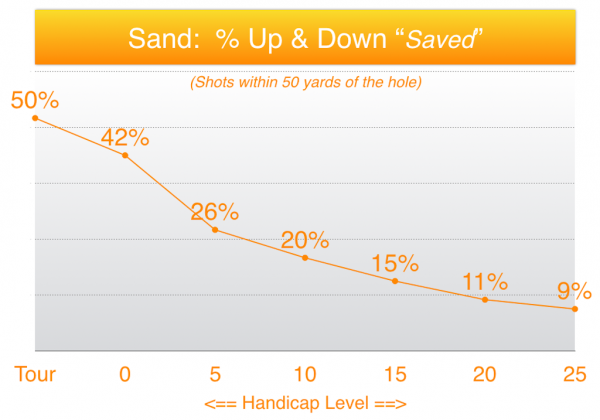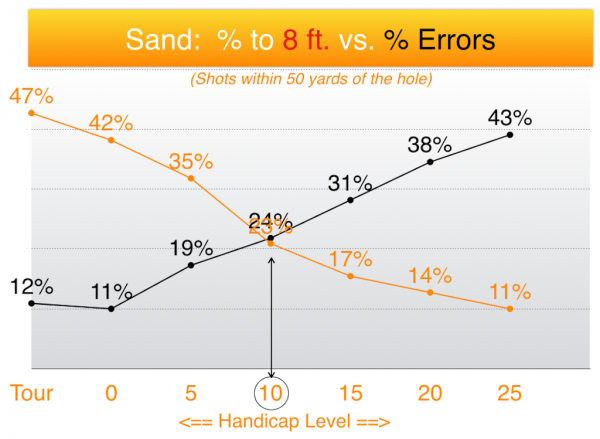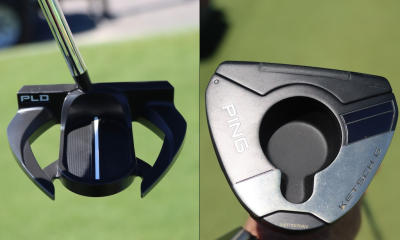Opinion & Analysis
Sand Saves: How often should you actually get “up-and-down” from the bunker based on your handicap?

This is a follow-up to my recent article,“How often should you … get ‘Up-and-Down’ based on your handicap?” That article focused on short game shots around the green that were NOT sand shots. If you have not read it, please do as I will not be repeating all of the supporting points in this article.
The traditional “Sand Save” stat has long been the accepted measure of skill from greenside sand. The chart below shows average performance in this area for PGA Tour players and an array of handicap levels. It refers to sand shots around the green and within 50 yards of the hole.
How do you fit in?

While sand saves, or “up and downs,” are nice, I do not believe them to be an appropriate or accurate measure of short game skill. Sand shots are quite a bit different than chipping or pitching, not only because they are a very different skill, but also because they tend to occupy a much smaller part of the overall game.
Non-sand short game shots generally range from a low of four or five shots per round at the top levels of the game, to as many as 15 shots at the other end. For perspective, the typical 15-19 handicap golfer averages about 10 non-sand short game shots per round. Shots from the sand are relatively rare, usually only 1 to 3 per round, and the 15-19 handicap golfer averages less than two.
Despite their reduced role, however, sand shots can have a meaningful impact on score. Why? It’s due to the difficulty of these shots and their high incidence of ERRORs, which I will discuss more below.
Again, I do NOT believe that “up and downs” are an appropriate or accurate measure of short game skill for two reasons:
- An up-and-down is actually the combination of two skills: Short Game and Putting.
- The stat totally ignores ERRORS, or shots that miss the green.
In my 30+ years of studying golf performance at all skill levels, I have found that FREQUENCY and SEVERITY of bad shots (errors) do so much more to influence a player’s scoring level than do all the good shots. I did not create my stat program to expose the errors in the game, but my early work and analysis revealed exactly how important they are, as well as their glaring omission from existing, traditional stats. Accordingly, I built the ability to capture data on the common errors in the game into ShotByShot.com.
The true measure of a player’s short game skill is their Strokes Gained in that facet. BUT, that is simply a number — a positive number is good, and a negative number is not so good. So how then to best display the skill that is associated with the Strokes Gained number? I believe the combination of the three stats below to be the correct way to display skill from the sand:
- Average putting distance when the green is successfully hit.
- Percent of shots hit to within 8 feet of the hole.
- Percent of errors, or shots that miss the putting surface.

In the chart above, the orange line represents the percentage of shots that the various levels of handicap golfers hit to within 8 feet of the hole. Why 8 feet? Our data has told us that this distance represents a good shot, just as 5 feet does in Chipping and Pitching around the green. The black line represents shots that miss the green (errors). For example, if you are the average 15-handicap golfer, you should be getting about one of every six sand shots to within 8 feet. You’ll miss the green with about one in every three sand shots, however, so you’ll make twice as many errors as you make good shots.
Note that the two lines cross at about a 10 handicap. A 10 handicap is actually a better golfer than 90 percent of the people who play the game regularly. Yet for every sand shot that they successfully get to within 8 feet of the hole, they are also sculling or leaving one in the sand and missing the green altogether. Further, these errors can lead to even more difficult positions, large numbers and real frustration.
Finally, a fear of the greenside sand can dramatically impact confidence and ability to hit greens. If you are having difficulty from the sand, I suggest that you first consult with your pro about your sand wedge. Is it the right loft and bounce for your game and the condition of your course’s sand? Then work to gain confidence in getting OUT. Just focus on getting the ball on the green. Forget the about the “save” until you can practice enough to reliably play the array of sand shots required with confidence.
If you’d like to see how greenside errors are affecting your game, as well as where you stack up to golfers in your handicap level, you can register for a FREE TRIAL of my strokes-gained analysis at ShotbyShot.com
- LIKE153
- LEGIT9
- WOW2
- LOL1
- IDHT2
- FLOP1
- OB1
- SHANK5
19th Hole
Vincenzi’s 2024 Zurich Classic of New Orleans betting preview

The PGA TOUR heads to New Orleans to play the 2023 Zurich Classic of New Orleans. In a welcome change from the usual stroke play, the Zurich Classic is a team event. On Thursday and Saturday, the teams play best ball, and on Friday and Sunday the teams play alternate shot.
TPC Louisiana is a par 72 that measures 7,425 yards. The course features some short par 4s and plenty of water and bunkers, which makes for a lot of exciting risk/reward scenarios for competitors. Pete Dye designed the course in 2004 specifically for the Zurich Classic, although the event didn’t make its debut until 2007 because of Hurricane Katrina.
Coming off of the Masters and a signature event in consecutive weeks, the field this week is a step down, and understandably so. Many of the world’s top players will be using this time to rest after a busy stretch.
However, there are some interesting teams this season with some stars making surprise appearances in the team event. Some notable teams include Patrick Cantlay and Xander Schauffele, Rory McIlroy and Shane Lowry, Collin Morikawa and Kurt Kitayama, Will Zalatoris and Sahith Theegala as well as a few Canadian teams, Nick Taylor and Adam Hadwin and Taylor Pendrith and Corey Conners.
Past Winners at TPC Louisiana
- 2023: Riley/Hardy (-30)
- 2022: Cantlay/Schauffele (-29)
- 2021: Leishman/Smith (-20)
- 2019: Palmer/Rahm (-26)
- 2018: Horschel/Piercy (-22)
- 2017: Blixt/Smith (-27)
2024 Zurich Classic of New Orleans Picks
Tom Hoge/Maverick McNealy +2500 (DraftKings)
Tom Hoge is coming off of a solid T18 finish at the RBC Heritage and finished T13 at last year’s Zurich Classic alongside Harris English.
This season, Hoge is having one of his best years on Tour in terms of Strokes Gained: Approach. In his last 24 rounds, the only player to top him on the category is Scottie Scheffler. Hoge has been solid on Pete Dye designs, ranking 28th in the field over his past 36 rounds.
McNealy is also having a solid season. He’s finished T6 at the Waste Management Phoenix Open and T9 at the PLAYERS Championship. He recently started working with world renowned swing coach, Butch Harmon, and its seemingly paid dividends in 2024.
Keith Mitchell/Joel Dahmen +4000 (DraftKings)
Keith Mitchell is having a fantastic season, finishing in the top-20 of five of his past seven starts on Tour. Most recently, Mitchell finished T14 at the Valero Texas Open and gained a whopping 6.0 strokes off the tee. He finished 6th at last year’s Zurich Classic.
Joel Dahmen is having a resurgent year and has been dialed in with his irons. He also has a T11 finish at the PLAYERS Championship at TPC Sawgrass which is another Pete Dye track. With Mitchell’s length and Dahmen’s ability to put it close with his short irons, the Mitchell/Dahmen combination will be dangerous this week.
Taylor Moore/Matt NeSmith +6500 (DraftKings)
Taylor Moore has quickly developed into one of the more consistent players on Tour. He’s finished in the top-20 in three of his past four starts, including a very impressive showing at The Masters, finishing T20. He’s also finished T4 at this event in consecutive seasons alongside Matt NeSmith.
NeSmith isn’t having a great 2024, but has seemed to elevate his game in this format. He finished T26 at Pete Dye’s TPC Sawgrass, which gives the 30-year-old something to build off of. NeSmith is also a great putter on Bermudagrass, which could help elevate Moore’s ball striking prowess.
- LIKE6
- LEGIT3
- WOW1
- LOL1
- IDHT0
- FLOP3
- OB1
- SHANK1
19th Hole
Vincenzi’s 2024 LIV Adelaide betting preview: Cam Smith ready for big week down under

After having four of the top twelve players on the leaderboard at The Masters, LIV Golf is set for their fifth event of the season: LIV Adelaide.
For both LIV fans and golf fans in Australia, LIV Adelaide is one of the most anticipated events of the year. With 35,000 people expected to attend each day of the tournament, the Grange Golf Club will be crawling with fans who are passionate about the sport of golf. The 12th hole, better known as “the watering hole”, is sure to have the rowdiest of the fans cheering after a long day of drinking some Leishman Lager.
The Grange Golf Club is a par-72 that measures 6,946 yards. The course features minimal resistance, as golfers went extremely low last season. In 2023, Talor Gooch shot consecutive rounds of 62 on Thursday and Friday, giving himself a gigantic cushion heading into championship Sunday. Things got tight for a while, but in the end, the Oklahoma State product was able to hold off The Crushers’ Anirban Lahiri for a three-shot victory.
The Four Aces won the team competition with the Range Goats finishing second.
*All Images Courtesy of LIV Golf*
Past Winners at LIV Adelaide
- 2023: Talor Gooch (-19)
Stat Leaders Through LIV Miami
Green in Regulation
- Richard Bland
- Jon Rahm
- Paul Casey
Fairways Hit
- Abraham Ancer
- Graeme McDowell
- Henrik Stenson
Driving Distance
- Bryson DeChambeau
- Joaquin Niemann
- Dean Burmester
Putting
- Cameron Smith
- Louis Oosthuizen
- Matt Jones
2024 LIV Adelaide Picks
Cameron Smith +1400 (DraftKings)
When I pulled up the odds for LIV Adelaide, I was more than a little surprised to see multiple golfers listed ahead of Cameron Smith on the betting board. A few starts ago, Cam finished runner-up at LIV Hong Kong, which is a golf course that absolutely suits his eye. Augusta National in another course that Smith could roll out of bed and finish in the top-ten at, and he did so two weeks ago at The Masters, finishing T6.
At Augusta, he gained strokes on the field on approach, off the tee (slightly), and of course, around the green and putting. Smith able to get in the mix at a major championship despite coming into the week feeling under the weather tells me that his game is once again rounding into form.
The Grange Golf Club is another course that undoubtedly suits the Australian. Smith is obviously incredibly comfortable playing in front of the Aussie faithful and has won three Australian PGA Championship’s. The course is very short and will allow Smith to play conservative off the tee, mitigating his most glaring weakness. With birdies available all over the golf course, there’s a chance the event turns into a putting contest, and there’s no one on the planet I’d rather have in one of those than Cam Smith.

Louis Oosthuizen +2200 (DraftKings)
Louis Oosthuizen has simply been one of the best players on LIV in the 2024 seas0n. The South African has finished in the top-10 on the LIV leaderboard in three of his five starts, with his best coming in Jeddah, where he finished T2. Perhaps more impressively, Oosthuizen finished T7 at LIV Miami, which took place at Doral’s “Blue Monster”, an absolutely massive golf course. Given that Louis is on the shorter side in terms of distance off the tee, his ability to play well in Miami shows how dialed he is with the irons this season.
In addition to the LIV finishes, Oosthuizen won back-to-back starts on the DP World Tour in December at the Alfred Dunhill Championship and the Mauritus Open. He also finished runner-up at the end of February in the International Series Oman. The 41-year-old has been one of the most consistent performers of 2024, regardless of tour.
For the season, Louis ranks 4th on LIV in birdies made, T9 in fairways hit and first in putting. He ranks 32nd in driving distance, but that won’t be an issue at this short course. Last season, he finished T11 at the event, but was in decent position going into the final round but fell back after shooting 70 while the rest of the field went low. This season, Oosthuizen comes into the event in peak form, and the course should be a perfect fit for his smooth swing and hot putter this week.

- LIKE12
- LEGIT3
- WOW0
- LOL1
- IDHT0
- FLOP1
- OB1
- SHANK1
Opinion & Analysis
The Wedge Guy: What really makes a wedge work? Part 1

Of all the clubs in our bags, wedges are almost always the simplest in construction and, therefore, the easiest to analyze what might make one work differently from another if you know what to look for.
Wedges are a lot less mysterious than drivers, of course, as the major brands are working with a lot of “pixie dust” inside these modern marvels. That’s carrying over more to irons now, with so many new models featuring internal multi-material technologies, and almost all of them having a “badge” or insert in the back to allow more complex graphics while hiding the actual distribution of mass.
But when it comes to wedges, most on the market today are still single pieces of molded steel, either cast or forged into that shape. So, if you look closely at where the mass is distributed, it’s pretty clear how that wedge is going to perform.
To start, because of their wider soles, the majority of the mass of almost any wedge is along the bottom third of the clubhead. So, the best wedge shots are always those hit between the 2nd and 5th grooves so that more mass is directly behind that impact. Elite tour professionals practice incessantly to learn to do that consistently, wearing out a spot about the size of a penny right there. If impact moves higher than that, the face is dramatically thinner, so smash factor is compromised significantly, which reduces the overall distance the ball will fly.
Every one of us, tour players included, knows that maddening shot that we feel a bit high on the face and it doesn’t go anywhere, it’s not your fault.
If your wedges show a wear pattern the size of a silver dollar, and centered above the 3rd or 4th groove, you are not getting anywhere near the same performance from shot to shot. Robot testing proves impact even two to three grooves higher in the face can cause distance loss of up to 35 to 55 feet with modern ‘tour design’ wedges.
In addition, as impact moves above the center of mass, the golf club principle of gear effect causes the ball to fly higher with less spin. Think of modern drivers for a minute. The “holy grail” of driving is high launch and low spin, and the driver engineers are pulling out all stops to get the mass as low in the clubhead as possible to optimize this combination.
Where is all the mass in your wedges? Low. So, disregarding the higher lofts, wedges “want” to launch the ball high with low spin – exactly the opposite of what good wedge play requires penetrating ball flight with high spin.
While almost all major brand wedges have begun putting a tiny bit more thickness in the top portion of the clubhead, conventional and modern ‘tour design’ wedges perform pretty much like they always have. Elite players learn to hit those crisp, spinny penetrating wedge shots by spending lots of practice time learning to consistently make contact low in the face.
So, what about grooves and face texture?
Grooves on any club can only do so much, and no one has any material advantage here. The USGA tightly defines what we manufacturers can do with grooves and face texture, and modern manufacturing techniques allow all of us to push those limits ever closer. And we all do. End of story.
Then there’s the topic of bounce and grinds, the most complex and confusing part of the wedge formula. Many top brands offer a complex array of sole configurations, all of them admittedly specialized to a particular kind of lie or turf conditions, and/or a particular divot pattern.
But if you don’t play the same turf all the time, and make the same size divot on every swing, how would you ever figure this out?
The only way is to take any wedge you are considering and play it a few rounds, hitting all the shots you face and observing the results. There’s simply no other way.
So, hopefully this will inspire a lively conversation in our comments section, and I’ll chime in to answer any questions you might have.
And next week, I’ll dive into the rest of the wedge formula. Yes, shafts, grips and specifications are essential, too.
- LIKE32
- LEGIT7
- WOW1
- LOL1
- IDHT2
- FLOP3
- OB1
- SHANK3
-

 19th Hole2 weeks ago
19th Hole2 weeks agoDave Portnoy places monstrous outright bet for the 2024 Masters
-

 19th Hole2 weeks ago
19th Hole2 weeks agoTiger Woods arrives at 2024 Masters equipped with a putter that may surprise you
-

 19th Hole1 day ago
19th Hole1 day ago‘Absolutely crazy’ – Major champ lays into Patrick Cantlay over his decision on final hole of RBC Heritage
-

 19th Hole3 weeks ago
19th Hole3 weeks agoReport: Tiger Woods has ‘eliminated sex’ in preparation for the 2024 Masters
-

 19th Hole1 week ago
19th Hole1 week agoTwo star names reportedly blanked Jon Rahm all week at the Masters
-

 19th Hole2 days ago
19th Hole2 days agoJustin Thomas on the equipment choice of Scottie Scheffler that he thinks is ‘weird’
-

 19th Hole1 week ago
19th Hole1 week agoReport: LIV Golf identifies latest star name they hope to sign to breakaway tour
-

 19th Hole1 week ago
19th Hole1 week agoNeal Shipley presser ends in awkward fashion after reporter claims Tiger handed him note on 8th fairway























Brad
Aug 3, 2018 at 5:01 am
The best thing to do on many of the bunkers around here is to take your putter or a 7 iron and just chip it out on the lowest side of the bunker, regardless of what direction that may be. Many of the bunkers are like wet concrete around here and the bunker technique used by most pros and taught by most coaching pros is entirely worthless and will only result in a skulled bunker shot 80% or more of the time. I would rather hit a flop shot over a bunker or over a 50 foot tall tree from a hard pan lie than have to get it out of most bunkers.
I would just love to see some of the best pros on tour get out of some of the kind of bunkers we have to play in sometime. There would be no end to the complaints from them I’m sure…
DaveyD
Aug 2, 2018 at 11:02 am
The charts above should be explained by the number of data points used to create the statistics. While the overall trends aren’t surprising and are most likely expected, these types of stats are kept for your players, but less likely to be kept as the handicap increases.
The last comment is in regard to putting, or rather the putting surface- in general. An assumption might be made that better golfers might play on better courses with better-maintained greens which could positively impact putting success.
DaveyD
Aug 2, 2018 at 11:03 am
The “your players” above should be “tour players”
Poot
Aug 2, 2018 at 2:04 am
You ain’t applying this to Links bunkers, that’s for sure. We saw what happened at Carnoustie last week, they were lucky just to get it out.
So, another meaningless “you’re an amateur and you suck” statistical analysis.
Paul
Aug 1, 2018 at 10:54 pm
Makes me feel better about my sand play!
I thought I was pretty average but I’m actually doing ok!
Tom54
Aug 1, 2018 at 2:21 pm
Kevin explains it well. Our bunkers at our course aren’t the greatest either. Depth of sand inconsistent. One shot you hit couple inches behind and it comes out great. Next bunker you’re in there’s no sand, the club bounces into the ball and over the green it goes. Lots of times our group plays move it out of footprints. Pros play off perfect lies why shouldn’t we?
Tee-Bone
Aug 1, 2018 at 1:58 pm
Strokes Gained on the PGA Tour are based on the averages of the field. Where are the averages from with your Strokes Gained programs?
Peter Sanders
Aug 2, 2018 at 9:09 am
Good Q! Our Strokes Gained model is based upon the average Scratch player. We calculate each players SG # vs. Scratch and then compare it to the average SG #’s in each facet for the player’s Target handicap range. It works!
Kevin
Aug 1, 2018 at 11:05 am
Sand save recovery stats are skewed as i’d guess the majority of amateurs aren’t playing courses where the greenside bunkers have several inches of sand and perfectly manicured like on tour. factor in that thousands of courses have little to no sand in some bunkers and the liklihood of a skull is much higher than a pga course. i always find it amusing when watching an instruction program on GC and they mention opening face and hitting 3 inches behind the ball. good luck when you come play in ohio and the bunker is hard packed. and its not goat tracks…a lot of really nice courses simply can’t afford to constantly replace/fill sand in their bunkers.
Mat
Aug 1, 2018 at 5:33 pm
Complete agreement. Sand, believe it or not, is expensive and getting rare. Traps are not worthy of a lot of practice outside of knowing your lie (your feet will tell you how far you sink in is how far behind the ball you enter) and getting out in one shot. If you’re a 10+, that’s the biggest challenge. Get out and two putt for bogey. Don’t take two to get out – that’s the card killer.
Pete McGill
Aug 2, 2018 at 2:08 am
True. My course has one hole with the only two bunkers. Players walk off with either 100% or zero in sand saves.